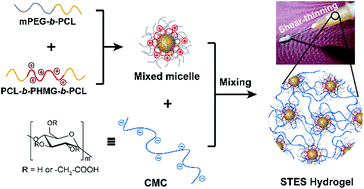当前位置:
X-MOL 学术
›
Biomater. Sci.
›
论文详情
Our official English website, www.x-mol.net, welcomes your
feedback! (Note: you will need to create a separate account there.)
A shear-thinning electrostatic hydrogel with antibacterial activity by nanoengineering of polyelectrolytes.
Biomaterials Science ( IF 5.8 ) Pub Date : 2020-01-10 , DOI: 10.1039/c9bm01386e Yanhui Zhu 1 , Qiaojie Luo , Hongjie Zhang , Qiuquan Cai , Xiaodong Li , Zhiquan Shen , Weipu Zhu
Biomaterials Science ( IF 5.8 ) Pub Date : 2020-01-10 , DOI: 10.1039/c9bm01386e Yanhui Zhu 1 , Qiaojie Luo , Hongjie Zhang , Qiuquan Cai , Xiaodong Li , Zhiquan Shen , Weipu Zhu
Affiliation

|
Injectable shear-thinning hydrogels can be prepared by the non-covalent interactions between hydrophilic polymers. Although electrostatic force is a typical non-covalent interaction, direct mixing of two oppositely charged polyelectrolytes usually leads to a complex coacervate rather than an injectable hydrogel. Herein, a facile approach is proposed to prepare a shear-thinning hydrogel by nanoengineering of polyelectrolytes. Nanosized cationic micelles with electroneutral shells were prepared by mixing methoxyl poly(ethylene glycol)-block-poly(ε-caprolactone) and poly(ε-caprolactone)-block-poly(hexamethylene guanidine) hydrochloride-block-poly(ε-caprolactone) in an aqueous solution. When sodium carboxymethyl cellulose was added into the micellar solution, the outer poly(ethylene glycol) shell of mixed micelles prevented the instant electrostatic interaction between poly(hexamethylene guanidine) hydrochloride segments and sodium carboxymethyl cellulose, resulting in a homogenous shear-thinning electrostatic (STES) hydrogel. Because of the cationic poly(hexamethylene guanidine) hydrochloride segments, this hydrogel exhibits strong antibacterial activity against both Gram-positive and Gram-negative bacteria. Furthermore, the poly(ε-caprolactone) core of the mixed micelles can efficiently encapsulate a hydrophobic drug. In this work, curcumin-loaded STES hydrogel prepared by this method was used as wound dressing material that can promote wound healing even in infected wounds by further reducing bacterial infection via releasing curcumin. The present study provides a facile strategy to prepare shear-thinning antibacterial hydrogels from polyelectrolytes, which has great potential in biomedical application.
中文翻译:

剪切稀化的静电水凝胶,具有通过纳米工程聚合电解质的抗菌活性。
可以通过亲水性聚合物之间的非共价相互作用制备可注射的剪切稀化水凝胶。尽管静电力是典型的非共价相互作用,但是两个带相反电荷的聚电解质的直接混合通常会导致复合凝聚层而不是可注射的水凝胶。在此,提出了一种通过聚电解质的纳米工程来制备剪切稀化水凝胶的简便方法。通过混合甲氧基聚(乙二醇)-嵌段-聚(ε-己内酯)和聚(ε-己内酯)-嵌段-聚(六亚甲基胍)盐酸盐-嵌段-聚(ε-己内酯)制备具有电中性壳的纳米级阳离子胶束在水溶液中。当将羧甲基纤维素钠添加到胶束溶液中时,混合胶束的聚(乙二醇)外壳阻止了聚(六亚甲基胍)盐酸盐链段和羧甲基纤维素钠之间的瞬时静电相互作用,从而产生了均一的剪切稀化静电(STES)水凝胶。由于阳离子聚(六亚甲基胍)盐酸盐片段,这种水凝胶对革兰氏阳性菌和革兰氏阴性菌均显示出强大的抗菌活性。此外,混合胶束的聚(ε-己内酯)核心可以有效地包封疏水性药物。在这项工作中,通过这种方法制备的负载姜黄素的STES水凝胶被用作伤口敷料,即使通过释放姜黄素进一步减少细菌感染,也可以促进伤口愈合,甚至在感染的伤口中也是如此。
更新日期:2020-03-03
中文翻译:

剪切稀化的静电水凝胶,具有通过纳米工程聚合电解质的抗菌活性。
可以通过亲水性聚合物之间的非共价相互作用制备可注射的剪切稀化水凝胶。尽管静电力是典型的非共价相互作用,但是两个带相反电荷的聚电解质的直接混合通常会导致复合凝聚层而不是可注射的水凝胶。在此,提出了一种通过聚电解质的纳米工程来制备剪切稀化水凝胶的简便方法。通过混合甲氧基聚(乙二醇)-嵌段-聚(ε-己内酯)和聚(ε-己内酯)-嵌段-聚(六亚甲基胍)盐酸盐-嵌段-聚(ε-己内酯)制备具有电中性壳的纳米级阳离子胶束在水溶液中。当将羧甲基纤维素钠添加到胶束溶液中时,混合胶束的聚(乙二醇)外壳阻止了聚(六亚甲基胍)盐酸盐链段和羧甲基纤维素钠之间的瞬时静电相互作用,从而产生了均一的剪切稀化静电(STES)水凝胶。由于阳离子聚(六亚甲基胍)盐酸盐片段,这种水凝胶对革兰氏阳性菌和革兰氏阴性菌均显示出强大的抗菌活性。此外,混合胶束的聚(ε-己内酯)核心可以有效地包封疏水性药物。在这项工作中,通过这种方法制备的负载姜黄素的STES水凝胶被用作伤口敷料,即使通过释放姜黄素进一步减少细菌感染,也可以促进伤口愈合,甚至在感染的伤口中也是如此。











































 京公网安备 11010802027423号
京公网安备 11010802027423号